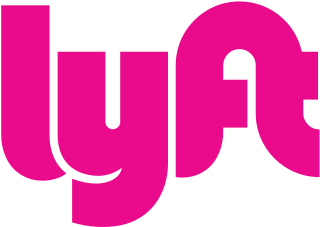Related Research Articles

Carpooling is the sharing of car journeys so that more than one person travels in a car, and prevents the need for others to have to drive to a location themselves. Carpooling is considered a Demand-Responsive Transport (DRT) service.

Uber Technologies, Inc., commonly referred to as Uber, is an American multinational transportation company that provides ride-hailing services, courier services, food delivery, and freight transport. It is headquartered in San Francisco, California, and operates in approximately 70 countries and 10,500 cities worldwide. It is the largest ridesharing company worldwide with over 150 million monthly active users and 6 million active drivers and couriers. It facilitates an average of 28 million trips per day and has facilitated 47 billion trips since its inception in 2010. In 2023, the company had a take rate of 28.7% for mobility services and 18.3% for food delivery.
Internet privacy involves the right or mandate of personal privacy concerning the storage, re-purposing, provision to third parties, and display of information pertaining to oneself via the Internet. Internet privacy is a subset of data privacy. Privacy concerns have been articulated from the beginnings of large-scale computer sharing and especially relate to mass surveillance.

Windows Error Reporting (WER) is a crash reporting technology introduced by Microsoft with Windows XP and included in later Windows versions and Windows Mobile 5.0 and 6.0. Not to be confused with the Dr. Watson debugging tool which left the memory dump on the user's local machine, Windows Error Reporting collects and offers to send post-error debug information using the Internet to Microsoft when an application crashes or stops responding on a user's desktop. No data is sent without the user's consent. When a crash dump reaches the Microsoft server, it is analyzed, and information about a solution is sent back to the user if available. Solutions are served using Windows Error Reporting Responses. Windows Error Reporting runs as a Windows service. Kinshuman Kinshumann is the original architect of WER. WER was also included in the Association for Computing Machinery (ACM) hall of fame for its impact on the computing industry.

Lyft, Inc. is an American company offering mobility as a service, ride-hailing, vehicles for hire, motorized scooters, a bicycle-sharing system, rental cars, and food delivery in the United States and select cities in Canada. Lyft sets fares, which vary using a dynamic pricing model based on local supply and demand at the time of the booking and are quoted to the customer in advance, and receives a commission from each booking. Lyft is the second-largest ridesharing company in the United States after Uber.
Privacy-enhancing technologies (PET) are technologies that embody fundamental data protection principles by minimizing personal data use, maximizing data security, and empowering individuals. PETs allow online users to protect the privacy of their personally identifiable information (PII), which is often provided to and handled by services or applications. PETs use techniques to minimize an information system's possession of personal data without losing functionality. Generally speaking, PETs can be categorized as either hard or soft privacy technologies.

Shared transport or shared mobility is a transportation system where travelers share a vehicle either simultaneously as a group or over time as personal rental, and in the process share the cost of the journey, thus purportedly creating a hybrid between private vehicle use and mass or public transport. It is a transportation strategy that allows users to access transportation services on an as-needed basis. Shared mobility is an umbrella term that encompasses a variety of transportation modes including carsharing, Bicycle-sharing systems, ridesharing companies, carpools, and microtransit.

Zimride by Enterprise Holdings was an American carpool program that matched inter-city drivers and passengers through social networking services. It was offered to universities and businesses as a matchmaking service. The company was founded in May 2007. After the launch of the Lyft app in May 2012 for intra-city rides, the Lyft app rapidly grew and became the focus of the company. Zimride officially renamed as Lyft in May 2013, and the Zimride service was sold to Enterprise Holdings in July 2013. As of July 2013, the service had over 350,000 users and had partnerships with Facebook and Zipcar.

Digital privacy is often used in contexts that promote advocacy on behalf of individual and consumer privacy rights in e-services and is typically used in opposition to the business practices of many e-marketers, businesses, and companies to collect and use such information and data. Digital privacy, a crucial aspect of modern online interactions and services, can be defined under three sub-related categories: information privacy, communication privacy, and individual privacy.
Since the arrival of early social networking sites in the early 2000s, online social networking platforms have expanded exponentially, with the biggest names in social media in the mid-2010s being Facebook, Instagram, Twitter and Snapchat. The massive influx of personal information that has become available online and stored in the cloud has put user privacy at the forefront of discussion regarding the database's ability to safely store such personal information. The extent to which users and social media platform administrators can access user profiles has become a new topic of ethical consideration, and the legality, awareness, and boundaries of subsequent privacy violations are critical concerns in advance of the technological age.

Wingz, Inc. is a vehicle for hire company that provides private, scheduled, and fixed-price rides in 30 major cities across the United States via mobile app. The service provides rides anywhere in the cities it serves, with a focus on airports. Wingz offers the ability to request specific drivers for rides and allows users to build a list of their favorite drivers for future bookings.

A ridesharing company, ride-hailing service, is a company that, via websites and mobile apps, matches passengers with drivers of vehicles for hire that, unlike taxis, cannot legally be hailed from the street.
The legality of ridesharing companies by jurisdiction varies; in some areas they are considered to be illegal taxi operations, while in other areas, they are subject to regulations that can include requirements for driver background checks, fares, caps on the number of drivers in an area, insurance, licensing, and minimum wage.
Cross-device tracking is technology that enables the tracking of users across multiple devices such as smartphones, television sets, smart TVs, and personal computers.
Windows 10, a proprietary operating system released by Microsoft in July 2015, has been criticized by reviewers and users. Due to issues mostly about privacy, it has been the subject of a number of negative assessments by various groups.
Spatial cloaking is a privacy mechanism that is used to satisfy specific privacy requirements by blurring users’ exact locations into cloaked regions. This technique is usually integrated into applications in various environments to minimize the disclosure of private information when users request location-based service. Since the database server does not receive the accurate location information, a set including the satisfying solution would be sent back to the user. General privacy requirements include K-anonymity, maximum area, and minimum area.
A series of general strikes was coordinated on March 25, 2019 by Lyft and Uber drivers in Los Angeles, San Diego and San Francisco, California, United States led by rideshare advocate group Rideshare Drivers United. The strikes aimed to protest low wages, long hours, working conditions, and lack of benefits. The event was planned following Lyft's initial public offering. A second strike took place on May 8, 2019 in anticipation of Uber's initial public offering. The strike in response to Uber's IPO took place in 25 major cities across the United States, and were also joined by drivers in other locations worldwide where Uber operates.

Proposition 22 was a ballot initiative in California that became law after the November 2020 state election, passing with 59% of the vote and granting app-based transportation and delivery companies an exception to Assembly Bill 5 by classifying their drivers as "independent contractors", rather than "employees". The law exempts employers from providing the full suite of mandated employee benefits while instead giving drivers new protections:
Soft privacy technologies fall under the category of PETs, Privacy-enhancing technologies, as methods of protecting data. Soft privacy is a counterpart to another subcategory of PETs, called hard privacy. Soft privacy technology has the goal of keeping information safe, allowing services to process data while having full control of how data is being used. To accomplish this, soft privacy emphasizes the use of third-party programs to protect privacy, emphasizing auditing, certification, consent, access control, encryption, and differential privacy. Since evolving technologies like the internet, machine learning, and big data are being applied to many long-standing fields, we now need to process billions of datapoints every day in areas such as health care, autonomous cars, smart cards, social media, and more. Many of these fields rely on soft privacy technologies when they handle data.
The Drivers Cooperative or Co-Op Ride is an American ridesharing company and mobile app that is a workers cooperative, owned collectively by the drivers. The cooperative launched in May 2020 in New York City, with the first 2,500 drivers issued their ownership certificates in a media event.
References
- 1 2 3 Chan, Nelson D.; Shaheen, Susan A. (January 2012). "Ridesharing in North America: Past, Present, and Future" (PDF). Transport Reviews. 32 (1): 93–112. doi:10.1080/01441647.2011.621557. ISSN 0144-1647. S2CID 131187130.
- ↑ "Uber Privacy". privacy.uber.com. Retrieved 2019-03-14.
- ↑ Inc, Lyft. "Lyft Privacy Policy". Lyft. Retrieved 2019-04-21.
{{cite web}}:|last=has generic name (help) - ↑ "Reporter's Recording Guide". The Reporters Committee for Freedom of the Press. Retrieved 2020-12-01.
- ↑ Hallgren, Per; Orlandi, Claudio; Sabelfeld, Andrei (August 2017). "PrivatePool: Privacy-Preserving Ridesharing". 2017 IEEE 30th Computer Security Foundations Symposium (CSF). Santa Barbara, CA: IEEE. pp. 276–291. doi:10.1109/CSF.2017.24. ISBN 978-1-5386-3217-8. S2CID 10509617.
- ↑ Kikuchi, Hiroaki; Takahashi, Katsumi (July 2015). "Zipf distribution model for quantifying risk of re-identification from trajectory data". 2015 13th Annual Conference on Privacy, Security and Trust (PST). IEEE. pp. 14–21. doi:10.1109/pst.2015.7232949. ISBN 978-1-4673-7828-4.
- 1 2 3 4 5 6 Damiani, Maria L. (Oct 2014). "Location privacy models in mobile applications: conceptual view and research directions". GeoInformatica. 18 (4): 819–842. doi:10.1007/s10707-014-0205-7. S2CID 1536208. ProQuest 1562335430.
- ↑ Pingley, Aniket; Yu, Wei; Zhang, Nan; Fu, Xinwen; Zhao, Wei (July 2012). "A context-aware scheme for privacy-preserving location-based services". Computer Networks. 56 (11): 2551–2568. doi:10.1016/j.comnet.2012.03.022. ISSN 1389-1286.
- 1 2 Biswas, Pratima; Sairam, Ashok Singh (July 2018). "Modeling privacy approaches for location based services". Computer Networks. 140: 1–14. doi:10.1016/j.comnet.2018.04.016. ISSN 1389-1286. S2CID 47021116.
- ↑ Hashemi, Mahdi; Malek, Mohammad Reza (July 2012). "Protecting location privacy in mobile geoservices using fuzzy inference systems". Computers, Environment and Urban Systems. 36 (4): 311–320. doi:10.1016/j.compenvurbsys.2011.12.002. ISSN 0198-9715.
- ↑ Ji, Rui; Yang, Yupu (2013-06-19). "Smooth support vector learning for fuzzy rule-based classification systems". Intelligent Data Analysis. 17 (4): 679–695. doi:10.3233/ida-130600. ISSN 1571-4128.
- ↑ Zurbarán, Mayra; Wightman, Pedro; Brovelli, Maria; Oxoli, Daniele; Iliffe, Mark; Jimeno, Miguel; Salazar, Augusto (2018-08-17). "NRand-K: Minimizing the impact of location obfuscation in spatial analysis". Transactions in GIS. 22 (5): 1257–1274. doi:10.1111/tgis.12462. ISSN 1361-1682. S2CID 53013020.
- 1 2 Hua, Jingyu; Tong, Wei; Xu, Fengyuan; Zhong, Sheng (2017). "A Geo-Indistinguishable Location Perturbation Mechanism for Location-Based Services Supporting Frequent Queries". IEEE Transactions on Information Forensics and Security. 13 (5): 1155–1168. doi:10.1109/tifs.2017.2779402. ISSN 1556-6013. S2CID 25233842.